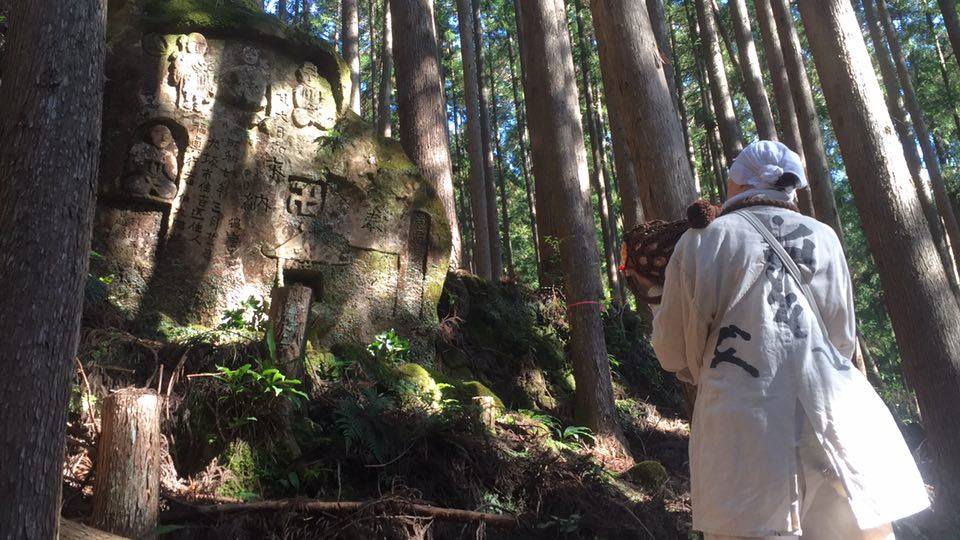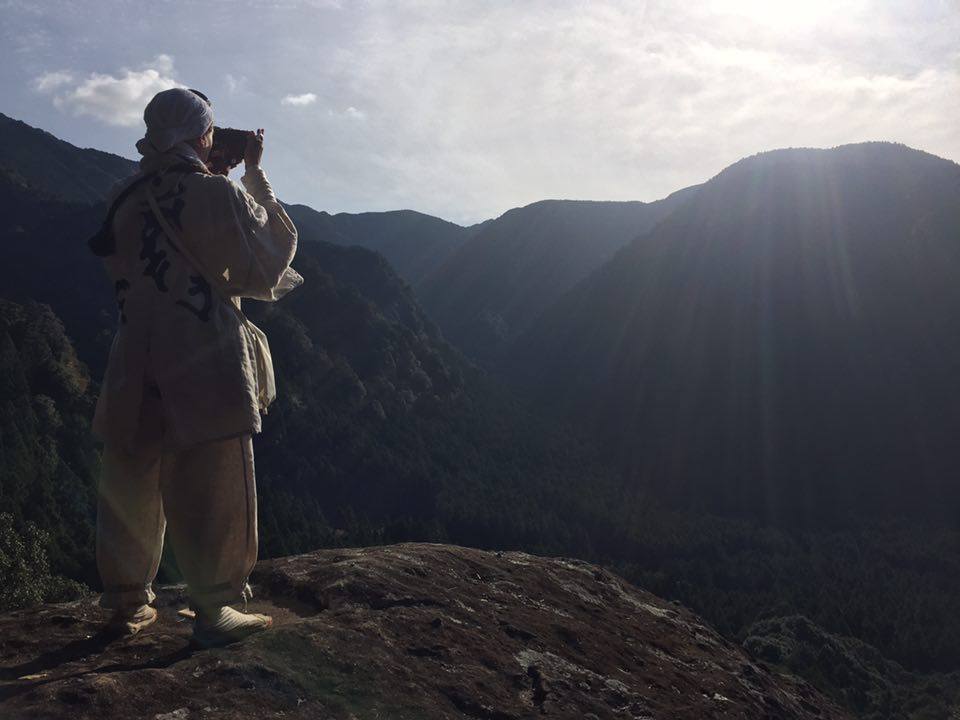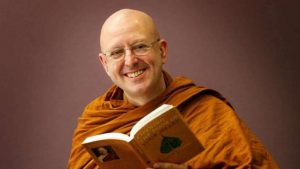
I am often asked whether I came to Japan in order to train in Shugendo. Just as often, I am asked whether I am an academic who is researching Shugendo for a PhD thesis. Neither is the case. Rather, it was serendipity around a yearning for being in nature and searching for spirit. In this three-part series, I discuss my own path to Shugendo, and my training and experiences as a Shugendo practitioner.
Meeting a mountain monk teacher
There I stood in front of the Hongu Grand Shrine, holding a phone number in my hand. It was the number of Tateishi Kosho, the mountain ascetic monk whom I knew from the Mark McQuire documentary Shugendo Now. I had watched this documentary repeatedly, looking for clues about what Shugendo was all about. The monk was a well-known gyoja (ascetic practitioner) and I felt anxious about calling him up.
I rang the number and the monk answered the phone. I mumbled an explanation in my then-broken Japanese. He asked for my location and told me to wait there. After 30 minutes I was not sure that I had understood him correctly, but then a white vehicle pulled up and out jumped a monk with a big grin, his hands extended for a handshake.
I climbed into the passenger seat and off he drove, I did not know where to, following the Kumano River and then turning off the main road and into a valley, and all the way to the end of the valley, passing paddy fields and gardens. When the car stopped I realized that we were at his temple, which I recognized instantly from the documentary.
The first course of action was meeting En no Gyoja (considered the founder of Shugendo) within the small temple. The monk asked me to burn some incense sticks while he lit candles in front of the statue. Then we performed three prostrations while he chanted. I did not yet know what the chant was all about.
We sat in the old wooden house next to the temple for a drink and chat. The monk asked me what I had come for. I tried to explain that I was curious about Shugendo and had read some books, but was now looking for a way to learn more about it from a practitioner. He listened and then suggested dinner and a bath.
There were two young Japanese women who cooked a simple meal and prepared the ofuro, “the honorable bath.” It was a traditional metal bathtub filled with cold water which was then heated using a wood burner. Coming from Tokyo, I was accustomed to running hot water from a tap. The women also insisted on laying out a futon on the second floor where I would sleep. It was a large, open-plan room that could easily sleep a whole group of people. I was a guest, they said, and as such did not have to “work.”
They told me that they were here for training and that they were doing “kaihōgyō.” I asked what it meant and was told of some hike in the mountains. If I wanted, I could come along the next morning. I happily agreed to join and then went to bed.
Kaihōgyō (回峰行) literally means “circling the mountain training.” This training practice is said to have been first established by a monk on Mount Hiei in the ninth century. Over the centuries, the practice became more structured and formalized, but the essence remained the same: walking a mountain circuit and offering prayers to deities at several places along the trail. These places can be temples and shrines, but often they are small Buddhist statues along the trail, or rocks, trees, waterfalls, and other natural places that embody a deity.

A taster of mountain training
It began raining during the night and by the early hours of the morning it was pouring down. It was still dark outside when one of the women came to my futon and told me that they would leave in half an hour. She added that I really did not have to join them, as I was a guest here and it was raining hard. This could have been the end of my Shugendo journey, but I got out of bed, although reluctantly, put on some clothes, and went downstairs.
The temple was already lit with candles and incense hung in the air. The women were performing full prostrations in front of the En no Gyoja statue while chanting. The speed at which they would lower themselves, lay flat on the ground, and then jump up made me feel dizzy just from watching. This was only a warm-up, they said, while I was wondering aloud about breakfast. I could have a sip of hot tea from the kitchen, they responded, but there was no meal until noon.
They found me a raincoat, a headlight, a wooden staff, and a conical hat, and told me that we would be walking a loop course of the mountain around the temple. Soon we started climbing a steep narrow path through the forest in the pitch dark. The women walked steadily without stopping until we reached the ridge line. There was a small stone statue of a deity under a gnarly old tree, which I would have missed had they not stopped before it and started chanting.
We continued walking downhill through the rain on a wide forest path with many slippery cobblestone steps, and I found out that this was the famous Kumano Kodo pilgrimage trail. By then it was daylight. There were several more stops for chanting in front of stone statues set along the path. When we reached a small village, I was totally wet and thought that this would be the end of the walk. The women smiled and said that we had just completed the easy part and the path would now become more difficult.
Walking through the village, I spotted a vending machine and really wanted to buy a drink, but this was not allowed. We walked by some gardens and into the forest and started climbing an even steeper slope. As the scenery changed from plantation forest to old-growth forest, the path became narrow and overgrown in parts.
At times I wondered whether there was a path at all and how the women knew the trail. Through the rain I saw old rice terraces where cedar trees now grew, and the lonely remnants of houses long abandoned. We reached a large boulder with Buddha images carved into them. There we stopped for more prayers and chanting.
We passed a small waterfall and crossed several gushing mountain streams. Any part of my clothing that had not been wet by then was now drenched. More and more large boulders appeared with narrow paths around them. Some boulders we walked across holding onto a rope. I already felt exhausted and began to wonder how much further we would walk.
Another steep climb took us to a massive exposed boulder. The women walked up the rock as if it was the most natural thing, while I went on all fours to follow them to the tip of the boulder, carefully watching my step as an amazing panorama unfolded in front of my eyes. Barely visible through the heavy rain was the deep valley below—cliffs and rock faces and forested mountains showed in the mist in the distance.
The women began to pray and chant at the top of their lungs, but their voices fighting the elements were swallowed by the wind and rain. I stood in amazement, and at that moment something happened: I wanted to be like these women. I wanted to come back here and train like them.

Yama gyo: training in the mountains
It took a few years until I could move from Tokyo to Kumano. I went back to the monk and asked for 21 days of kaihōgyō. This is a far cry from the 100 days of training that Shugendo monks at Kimpusen-ji, a temple on Mount Yoshino, undertake, not to mention the 1,000 days for which the famous “marathon monks” of Mount Hiei near Kyoto train.
On my first day I was guided around the course by a disciple who had taken up training at the temple. He walked in front and I walked behind and tried to remember the trail and the places for prayer. On the second day I walked in front and he pointed out the trail when I seemed totally lost. On the third day I was out by myself.
I still did not remember all the chants then, but I learned them later, memorizing them bit by bit. When I asked the monk whether he had any teachings for me, he pointed to the mountains and forest and said that they were the teachers and they would teach me.
He instructed me to walk at the same pace every day, neither fast nor slow, and not to look outside but to look inside, and to practice blowing the conch shell. He also told me to chant the mantra for Fudo myoo (Acala), the guardian deity of shugenja, and the mantra for En no Gyoja, the founder of Shugendo, while walking.

Sato gyo: training in the village
The day would start before dawn, bringing offerings to the temple and boiling water for tea. The first prayer, and the last, were said in front of the temple before departure still in the dark and after return before noon. Then preparing lunch, a couple of hours rest, and cleaning the temple and house, doing some other chores, preparing dinner, and evening prayer, followed by dinner and bedtime.
On some days, guests would come and were served tea and meals. If they stayed, the bath was prepared and futons were laid out for them. On other days, help was needed with weeding the vegetable plot or watching the rice fields to keep monkeys away.
This was not a retreat, I realized, but training throughout. There was no idle time and no time for anything that did not contribute to training. I had brought several books and wanted to “study” but there was no time.
I had many questions for my teacher, but many days I did not see him at all. This was time for reflection and introspection. He told me that I should write a diary every day and make a note of my thoughts and feelings. Diary time was mainly after dinner just before sleeping.
A typhoon hit the area during my training. The heavy rain over several days washed away the trail in several parts. Some massive landslides occurred. What to do? Was this a reason to pause or end the training? The kaihōgyō tradition prescribes that people who sign up should complete their training no matter what. I continued the training and walked around the affected areas in a large circle.
One day, the typhoon was directly over the area, and the rain was so heavy that my teacher decided it was too dangerous to go into the mountains. He instructed me to do “unshin kaihōgyō,” or walking the course in my mind, instead. I sat in the temple, closed my eyes, and started the walk in my mind. This was more difficult than the actual walk as I found that I could not visualize some parts of the trail at all.
I completed the 21 days training, mangyo! But there was no time to rest as “real life” hit home: I had to find a place to stay and some form of employment.

Practice means to continue
From then on I did seven days of kaihōgyō on the same trail every year in December for 10 years, and I was allowed to guide others along the trail many times, and to introduce them to the kaihōgyō practice.
Some years I walked with my monk teacher or with another disciple, and other years with people who came to join the kaihōgyō training for a few days only. The participants changed but the kaihōgyō trail and the training routine did not.
For many years, each day’s walk was followed by a goma fire ceremony at the teacher’s temple soon after arrival. I changed clothes quickly, then lit the candles, prepared the incense burners, and stood ready by the time the monk stepped into the hall.
I sat at the side of the goma table and observed my teacher closely. Learning by observation has been the traditional way of training. The teacher imparts with lessons when he sees fit.
Sometimes, when there were no other disciples around, he asked me to assist ringing the bell during the ceremony and to place goma prayer sticks into the fire, all the while chanting the various prayers I had memorized by then and blowing the conch shell. I learned to clean the goma table and to place all the items back into their correct place and prepare the offerings.
There is not much evidence of me having done the training and there is nothing to show for it. No rank achieved, no certificate obtained. I have my diary entries and the knowledge that I undertook the training. I still have not received the initiation for the goma fire ceremony that is held as evidence of accomplishment within the Shugendo community.
I realized that the initial 21 days, followed by the seven days each year, and several walks in between spread over 10 years amounted to the 100 days of training that is the start for the kaihōgyō monks of Mount Hiei. One hundred days of training means three months, but I found it difficult to set aside three weeks or even one week for training just before the busy Christmas and New Year season.
Despite having completed 10 years of training, my ego got the better of me. I asked my teacher whether I could receive a wooden fuda that stated my “achievement.” He looked at me with an inquisitive expression on his face, but later wrote the fuda and gave it to me at the mangyo goma.
At the “mangyo party,” a meal together at the end of training, my teacher asked me how I felt about the 10 years of training. It was difficult to say then, after all, I had not yet attained enlightenment. I knew that I had “piled up” this training and that I had learned lessons along the way, but the main lesson seemed to be: training continues!
Related features from BDG
From Alena to Yushu, Part 1: How I Found My Way to Shugendo













Shugendo used to have a specific goal – to gain enlightenment and gain supernatural abilities. And now? Is there enlightenment and abilities given by such practice?